| Listing 1 - 10 of 108 | << page >> |
Sort by
|
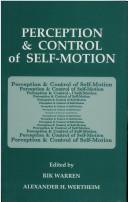
ISBN: 0805809090 Year: 1990 Publisher: Hillsdale (N.J.) : Erlbaum,
Abstract | Keywords | Export | Availability | Bookmark
 Loading...
Loading...Choose an application
- Reference Manager
- EndNote
- RefWorks (Direct export to RefWorks)
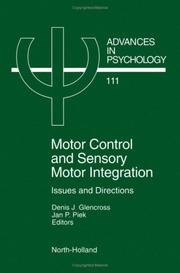
ISBN: 9780444819215 0444819215 9780080537009 0080537006 1280927194 9781280927195 9786610927197 6610927197 Year: 1995 Publisher: New York Elsevier
Abstract | Keywords | Export | Availability | Bookmark
 Loading...
Loading...Choose an application
- Reference Manager
- EndNote
- RefWorks (Direct export to RefWorks)
This volume evolved from a workshop which addressed the general area of motor control, and the broader problems of serial organisation and sensory-motor integration of human skills. A number of specific issues are highlighted, including the neural mechanisms and disabilities of sensory-motor integration, planning and programming of action, the dynamics of interlimb coordination, amendment and updating mechanisms, and in particular, perception-action coupling and the representation of action. Underlying much of the volume are the major theoretical issues which include the debate between computa
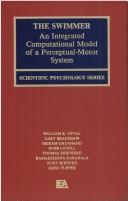
ISBN: 0805810706 Year: 1992 Publisher: Hillsdale Erlbaum
Abstract | Keywords | Export | Availability | Bookmark
 Loading...
Loading...Choose an application
- Reference Manager
- EndNote
- RefWorks (Direct export to RefWorks)
Book
ISBN: 0471920762 Year: 1989 Publisher: Chichester Wiley
Abstract | Keywords | Export | Availability | Bookmark
 Loading...
Loading...Choose an application
- Reference Manager
- EndNote
- RefWorks (Direct export to RefWorks)
Motor ability --- Perceptual-motor processes --- Motor Skills
Book
ISBN: 183962938X 1838808434 Year: 2020 Publisher: London : IntechOpen,
Abstract | Keywords | Export | Availability | Bookmark
 Loading...
Loading...Choose an application
- Reference Manager
- EndNote
- RefWorks (Direct export to RefWorks)
Perceptual-motor processes. --- Sensory-motor processes --- Movement, Psychology of --- Perception
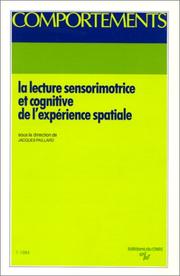
ISBN: 9782222035947 2222035945 Year: 1985 Publisher: Paris: CNRS,
Abstract | Keywords | Export | Availability | Bookmark
 Loading...
Loading...Choose an application
- Reference Manager
- EndNote
- RefWorks (Direct export to RefWorks)
Spatial behavior --- Space perception --- Perceptual-motor processes --- Cognition
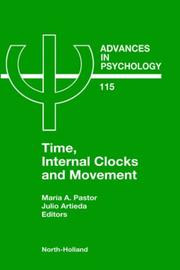
ISBN: 9780444821140 0444821147 9780080543048 0080543049 Year: 1996 Publisher: New York Elsevier
Abstract | Keywords | Export | Availability | Bookmark
 Loading...
Loading...Choose an application
- Reference Manager
- EndNote
- RefWorks (Direct export to RefWorks)
Interest in the concept of time has a long history and has been a topic of study for a wide range of investigators. No change can take place without specification of time. While philosophers and physicists have been intrigued by the concept of subjective perception of time and its relationship to real time, natural scientists have been concerned mainly with investigating time as a factor in understanding the behaviour of animals from the migratory habits of birds to the periodical breeding cycles. The immense bulk of temporal perception studies, the variety of approaches, methods of measurement and even terminology has led to a difficulty in reaching a global interpretation of the results. This book aims to give an integrative approach of time sense and to focus the analysis on temporal factors in the processing of movement, trying to link temporal perception studies in the final common pathway, that is motion. To give some clues of human brain integrative processes at higher levels. And, finally, to clarify the neurophysiological substrate of these operations.
Movement, Psychology of --- Neuropsychology --- Perceptual-motor processes --- Time perception
Book
Abstract | Keywords | Export | Availability | Bookmark
 Loading...
Loading...Choose an application
- Reference Manager
- EndNote
- RefWorks (Direct export to RefWorks)
To interact with the environment, an individual must code, store, and translate spatial information into the appropriate motor commands for achieving an outcome. Working from this premise, Vision and Goal-Directed Movement: Neurobehavioral Perspectives discusses how visual perception, attention, and memory are linked to the processes of movement preparation and execution. With contributions from active researchers in movement science, Vision and Goal-Directed Movement presents the latest theories on the utilization of vision in goal-directed movement control. As a resource for motor control and motor learning researchers, students, educators, and clinicians, Vision and Goal-Directed Movement offers the following: Comprehensive coverage of current behavior-based literature on the visual control of goal-directed movement; A systematic explication of the sensory and physiological processes and systems responsible for fast, accurate, and efficient performance; A solid foundation for further study of the sensory and neural systems responsible for precise goal-directed behavior; A discussion of how current research on vision and goal-directed movement can assist in creating efficient and safe work environments. Using research informed by neural imaging and magnetic brain stimulation, this text provides readers with a better understanding of the neural foundations for goal-directed movement, illustrates the flexibility of the human visuomotor system, and discusses how regulation of movements depends on the learning and developmental history of the performer. It begins by reviewing the works of R.S. Woodworth and the influence of his theories on current research. The majority of the chapters in the first section of the book take a behavioral and process-oriented approach to exploring goal-directed movement. The text then explores the sensory and neural foundations for goal-directed action, including issues related to both pursuit and saccadic eye movements as well as discussion of the specialization of various cortical systems for the regulation of movement. Especially relevant to professionals and scientists concerned with skill instruction and rehabilitation, the final part of the text provides a review of recent research on how and why limb control changes occur with practice and development. In addition, Vision and Goal-Directed Movement considers how the research presented can maximize precision, efficiency, and safety in workspace design. Vision and Goal-Directed Movement: Neurobehavioral Perspectives adds a unique offering to the literature base for motor behavior, demonstrating how advances in both behavioral and neurophysiological methods can inform theories related to the biological systems contributing to skilled performance.
Perceptual-motor processes. --- Motion perception (Vision) --- Visual perception.
Book
Year: 2002 Publisher: Alexandria, VA : U.S. Army Research Institute for the Behavioral and Social Sciences,
Abstract | Keywords | Export | Availability | Bookmark
 Loading...
Loading...Choose an application
- Reference Manager
- EndNote
- RefWorks (Direct export to RefWorks)
Thought and thinking. --- Perceptual-motor processes. --- Automation --- Human factors.
Book
Year: 2003 Publisher: Arlington, VA : ERIC Clearinghouse on Disabilities and Gifted Education,
Abstract | Keywords | Export | Availability | Bookmark
 Loading...
Loading...Choose an application
- Reference Manager
- EndNote
- RefWorks (Direct export to RefWorks)
| Listing 1 - 10 of 108 | << page >> |
Sort by
|

 Search
Search Feedback
Feedback About UniCat
About UniCat  Help
Help News
News